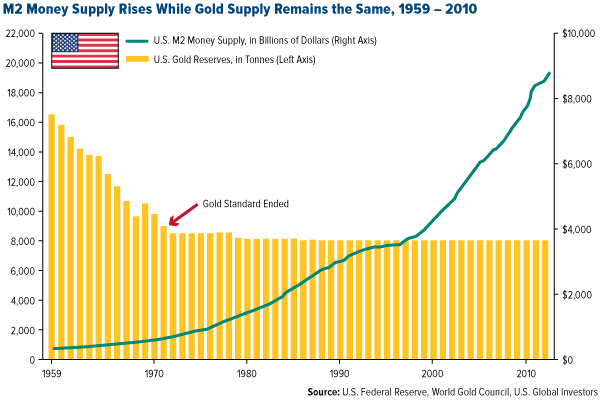History Rife With Disastrous Consequences Of Abandoning Gold Standard

About 100 years ago, in his testimony before Congress, banking giant J.P. Morgan famously stated: “Gold is money, and nothing else.” At the time, this was true in every sense of the word “money,” as the U.S. was still on the gold standard. Of course, that’s no longer the case.
Despite the fact that previous attempts in other countries to adopt fiat currency systems wreaked havoc on their economies, the U.S., under President Richard Nixon, cut all ties between the dollar and gold in 1971. Gold rose 2,330 percent through early 1980, from $35 per ounce to $850.
Today, money supply continues to expand while federal gold reserves remain at the same levels.
M2 Money Supply Rises While Gold Supply Remains the Same, 1959 – 2010
Many people still view the yellow metal as something more than just another asset. They also contend that it’s grossly undervalued. In a recent interview with Hard Assets Investor, author and veteran gold investing expert James Turk explained that the money we use now in transactions is not real money at all but a substitute for gold—real money—which he sees fundamentally valued at $12,000 per ounce.
That is to say, if the U.S. government decided tomorrow to return to the gold standard, one ounce of the metal could be valued as high as $12,000, according to Turk’s model.
The current fiat currency system in the U.S. is more than 40 years old. That’s much longer than many in the past lasted, including two of the earliest attempts by central bankers Johan Palmstruch and John Law, both of which I summarize below. Some readers might identify more than a few parallels between then and now.
Dutchman’s 1661 Paper Ponzi Scheme
a 1928 Federal Reserve Note
In the mid-1600s, a Dutch merchant named Johan Palmstruch founded the Stockholms Banco in Sweden, the first bank in Europe to print paper money. The Swedish currency at the time was the daler, essentially a copper plate. Palmstruch’s bank began holding these and issuing banknotes, which were exchangeable in any transaction and fully backed by the physical metal. At least, that’s what customers were told.
As you might imagine, people found these notes to be much more convenient than copper plates, and their popularity soared, but there was one (huge) problem. Palmstruch had been doling out so many paper bills, that their collective value soon exceeded the amount of metal on reserve. When customers heard the news, a major bank run occurred, but Palmstruch was unable to honor the rapidly-weakening notes.
By 1664, a mere three years into his monetary experiment, the Stockholms Banco was ruined and Palmstruch was jailed—just as Bernie Madoff would be three and a half centuries later.
Scottish Gambler Defrauds France With Worthless Paper
A little over 50 years later, in the early 1700s, a similar experiment was conducted in France, with even more disastrous consequences. This time, the perpetrator was a Scottish gambler and womanizer named John Law, who as a young man had been forced to flee Britain after he killed a man in a duel over a love interest—and bribed his way out of prison. After escaping jail time, Law spent 10 years or so gallivanting about Europe and developing his economic theories, which he outlined in an academic paper.
It was the Age of Enlightenment, when great iconoclastic thinkers such as Descartes, Locke and Newton emerged, changing our understanding of consciousness, politics and physics. Baroque music was all the rage in Europe, as were composers like Bach, Handel and Vivaldi. It was also a golden age of get-rich-quick schemes, and as investors, it’s important that we be aware of the history of human behavior.
[“source – forbes.com”]
